|
 Russula inquinata Russula inquinata
BiostatusPresent in region - Indigenous. Endemic
Images (click to enlarge)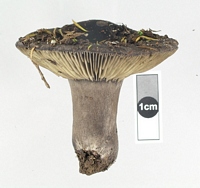
Owner: J.A. Cooper | 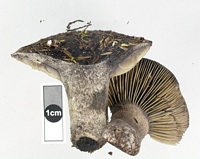
Owner: J.A. Cooper | 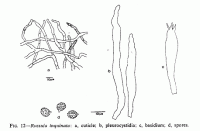 | 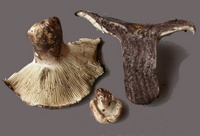
Owner: P. Leonard | 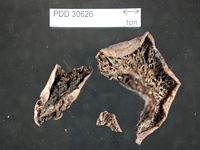
Caption: Dried type specimen
Owner: Herb PDD | 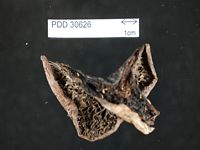
Caption: Dried type specimen
Owner: Herb PDD |
Article: McNabb, R.F.R. (1973). Russulaceae of New Zealand. 2. Russula Pers. ex S.F. Gray. New Zealand Journal of Botany 11(4): 673-730 (http://www.rsnz.org/publish/abstracts.php).
Description: pileus: 6-10 cm diam., plano-convex to centrally
depressed at maturity, viscid, glabrous, innately subpruinose under lens, velar
remnants absent, probably pallid when young, mid brown, dark brown, greyish
brown, or dark brownish grey at maturity, blackening when overmature: margins
entire, thick, moderately involute, non-pectinate. Cuticle 200-250 µm thick,
gelatinised at maturity, composed of obliquely ascending, interwoven, thin-walled,
septate hyphae 2-4.5 µm diam., often with dark brown contents in KOH, terminal
cells unspecialised; pilocystidia rare, embedded, cylindrical with strangulate
or capitulate apices, contents refractive in KOH, to 5 µm diam. lamellae: adnate, moderately crowded, thick, simple,
to 7 mm deep, dull creamy white with faint greyish tints, heavily discoloured
with black spots, blackening with age, lamellulae numerous, in 3 unequal series,
typically in sequence. stipe:
4-5 cm long, ± equal or tapering basally, 1.3-2.5 cm diam., dry, solid, subvelutinate
under lens, sordid greyish fawn to brownish grey, darker towards base; flesh
white at first, rapidly blackening on exposure to air. Cuticle composed of a
palisade of thin-walled, septate hyphae 3-4.5 µm diam., often with dark brown
contents in KOH, terminal cells unspecialised; caulocystidia rare, embedded,
similar to pilocystidia. spores: spore print not obtained; spores broadly
elliptical, obliquely apiculate, apiculus to 1.5 µm long, 7.5-9 X 6.5-8 µm,
ornamentation of amyloid verrucae and crests to 0.5 µm high, joined by fine
amyloid ridges and forming a complete or almost complete reticulum; plage absent.
hymenium: basidia tinted, clavate, 47-60 X 9-11.5
µm, 4-spored, sterigmata to 7 µm long; pleurocystidia scattered, numerous, narrow
fusiform, thin-walled, contents refractive in KOH, projecting to 20 µm beyond
basidia, apices acuminate, capitulate, or strangulate, 65-100 X 5.5-8 µm, cheilocystidia
similar to pleurocystidia but shorter. hymenophoral trama: heteromerous, intermixed, oleiferous
hyphae present. context of pileus: white, rapidly blackening on exposure
to air, firm, rather granular; structure heteromerous, clamp connections absent.
taste: lamellae and context acrid. chemical characters: FeSO4 on context— greyish green; KOH
on pileus—faint darkening; on context— faintly yellow; NH4OH on pileus and context—n.r.
Habitat: Solitary or in pairs under Nothofagus.
Notes: Young fruiting bodies of this species have not been collected, but if .R. inquinata follows the pattern of other species in the subsection, they are probably pallid in colour, darkening with maturity.
The blackening fructifications, firm context, and regularly arranged lamellulae indicate that R. inquinata belongs to section Compactae subsection Nigricantes Bat. as defined by Singer (1962). Russula inquinata is close to R. adusta (Pers. ex Fr.) Fr. but differs in the acrid taste, and the greyish green reaction to FeSO4 Russula adusta is a Northern Hemisphere species restricted to coniferous habitats. It belongs to the Compactae subsection of Russula as defined by Shaffer (1962).
|